service JAGUAR XJ6 1997 2.G User Guide
[x] Cancel search | Manufacturer: JAGUAR, Model Year: 1997, Model line: XJ6, Model: JAGUAR XJ6 1997 2.GPages: 227, PDF Size: 7.2 MB
Page 59 of 227
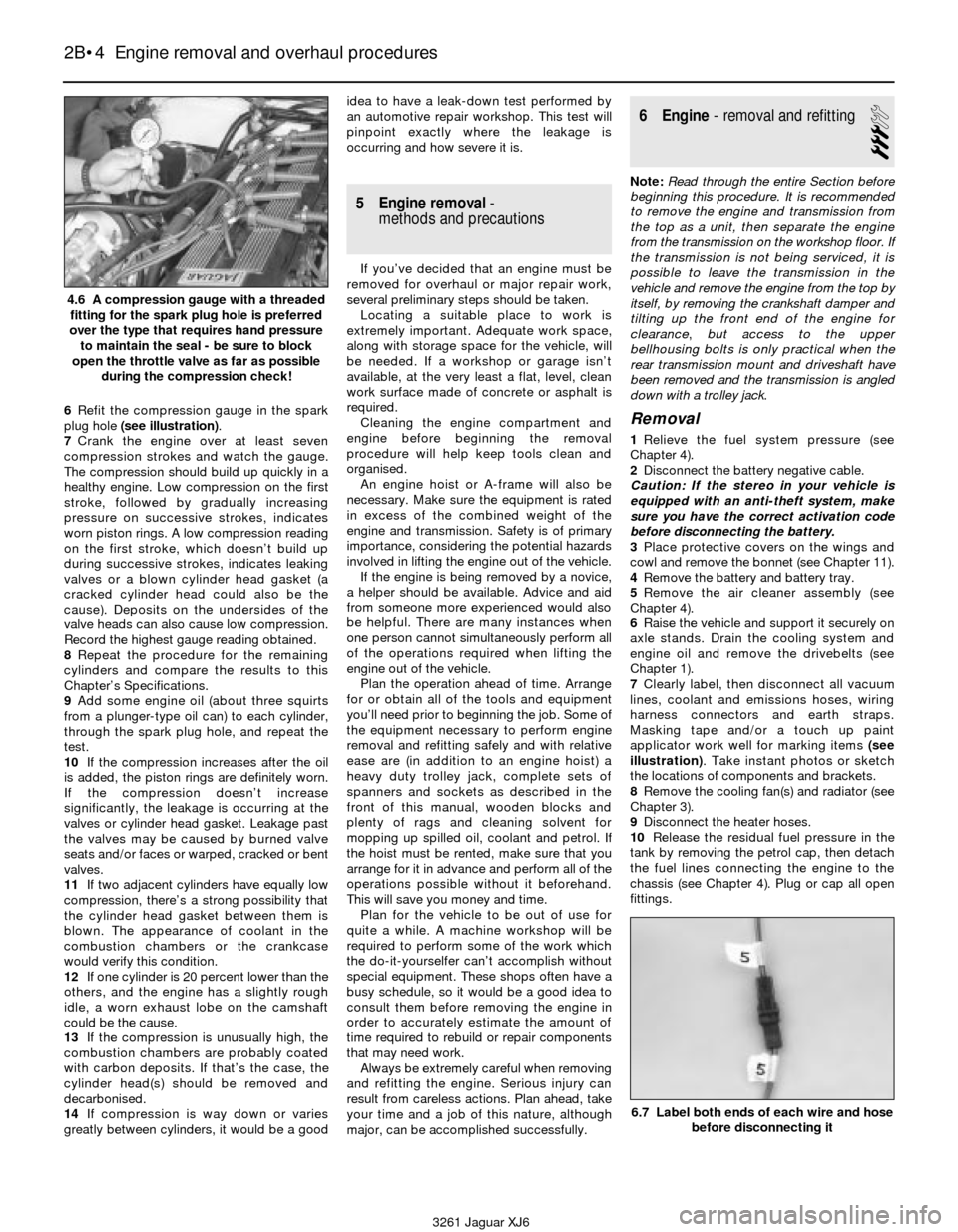
6Refit the compression gauge in the spark
plug hole (see illustration).
7Crank the engine over at least seven
compression strokes and watch the gauge.
The compression should build up quickly in a
healthy engine. Low compression on the first
stroke, followed by gradually increasing
pressure on successive strokes, indicates
worn piston rings. A low compression reading
on the first stroke, which doesn’t build up
during successive strokes, indicates leaking
valves or a blown cylinder head gasket (a
cracked cylinder head could also be the
cause). Deposits on the undersides of the
valve heads can also cause low compression.
Record the highest gauge reading obtained.
8Repeat the procedure for the remaining
cylinders and compare the results to this
Chapter’s Specifications.
9Add some engine oil (about three squirts
from a plunger-type oil can) to each cylinder,
through the spark plug hole, and repeat the
test.
10If the compression increases after the oil
is added, the piston rings are definitely worn.
If the compression doesn’t increase
significantly, the leakage is occurring at the
valves or cylinder head gasket. Leakage past
the valves may be caused by burned valve
seats and/or faces or warped, cracked or bent
valves.
11If two adjacent cylinders have equally low
compression, there’s a strong possibility that
the cylinder head gasket between them is
blown. The appearance of coolant in the
combustion chambers or the crankcase
would verify this condition.
12If one cylinder is 20 percent lower than the
others, and the engine has a slightly rough
idle, a worn exhaust lobe on the camshaft
could be the cause.
13If the compression is unusually high, the
combustion chambers are probably coated
with carbon deposits. If that’s the case, the
cylinder head(s) should be removed and
decarbonised.
14If compression is way down or varies
greatly between cylinders, it would be a goodidea to have a leak-down test performed by
an automotive repair workshop. This test will
pinpoint exactly where the leakage is
occurring and how severe it is.
5 Engine removal-
methods and precautions
If you’ve decided that an engine must be
removed for overhaul or major repair work,
several preliminary steps should be taken.
Locating a suitable place to work is
extremely important. Adequate work space,
along with storage space for the vehicle, will
be needed. If a workshop or garage isn’t
available, at the very least a flat, level, clean
work surface made of concrete or asphalt is
required.
Cleaning the engine compartment and
engine before beginning the removal
procedure will help keep tools clean and
organised.
An engine hoist or A-frame will also be
necessary. Make sure the equipment is rated
in excess of the combined weight of the
engine and transmission. Safety is of primary
importance, considering the potential hazards
involved in lifting the engine out of the vehicle.
If the engine is being removed by a novice,
a helper should be available. Advice and aid
from someone more experienced would also
be helpful. There are many instances when
one person cannot simultaneously perform all
of the operations required when lifting the
engine out of the vehicle.
Plan the operation ahead of time. Arrange
for or obtain all of the tools and equipment
you’ll need prior to beginning the job. Some of
the equipment necessary to perform engine
removal and refitting safely and with relative
ease are (in addition to an engine hoist) a
heavy duty trolley jack, complete sets of
spanners and sockets as described in the
front of this manual, wooden blocks and
plenty of rags and cleaning solvent for
mopping up spilled oil, coolant and petrol. If
the hoist must be rented, make sure that you
arrange for it in advance and perform all of the
operations possible without it beforehand.
This will save you money and time.
Plan for the vehicle to be out of use for
quite a while. A machine workshop will be
required to perform some of the work which
the do-it-yourselfer can’t accomplish without
special equipment. These shops often have a
busy schedule, so it would be a good idea to
consult them before removing the engine in
order to accurately estimate the amount of
time required to rebuild or repair components
that may need work.
Always be extremely careful when removing
and refitting the engine. Serious injury can
result from careless actions. Plan ahead, take
your time and a job of this nature, although
major, can be accomplished successfully.
6 Engine- removal and refitting
3
Note:Read through the entire Section before
beginning this procedure. It is recommended
to remove the engine and transmission from
the top as a unit, then separate the engine
from the transmission on the workshop floor. If
the transmission is not being serviced, it is
possible to leave the transmission in the
vehicle and remove the engine from the top by
itself, by removing the crankshaft damper and
tilting up the front end of the engine for
clearance,but access to the upper
bellhousing bolts is only practical when the
rear transmission mount and driveshaft have
been removed and the transmission is angled
down with a trolley jack.
Removal
1Relieve the fuel system pressure (see
Chapter 4).
2Disconnect the battery negative cable.
Caution: If the stereo in your vehicle is
equipped with an anti-theft system, make
sure you have the correct activation code
before disconnecting the battery.
3Place protective covers on the wings and
cowl and remove the bonnet (see Chapter 11).
4Remove the battery and battery tray.
5Remove the air cleaner assembly (see
Chapter 4).
6Raise the vehicle and support it securely on
axle stands. Drain the cooling system and
engine oil and remove the drivebelts (see
Chapter 1).
7Clearly label, then disconnect all vacuum
lines, coolant and emissions hoses, wiring
harness connectors and earth straps.
Masking tape and/or a touch up paint
applicator work well for marking items (see
illustration). Take instant photos or sketch
the locations of components and brackets.
8Remove the cooling fan(s) and radiator (see
Chapter 3).
9Disconnect the heater hoses.
10Release the residual fuel pressure in the
tank by removing the petrol cap, then detach
the fuel lines connecting the engine to the
chassis (see Chapter 4). Plug or cap all open
fittings.
2B•4 Engine removal and overhaul procedures
4.6 A compression gauge with a threaded
fitting for the spark plug hole is preferred
over the type that requires hand pressure
to maintain the seal - be sure to block
open the throttle valve as far as possible
during the compression check!
6.7 Label both ends of each wire and hose
before disconnecting it
3261 Jaguar XJ6
Page 61 of 227
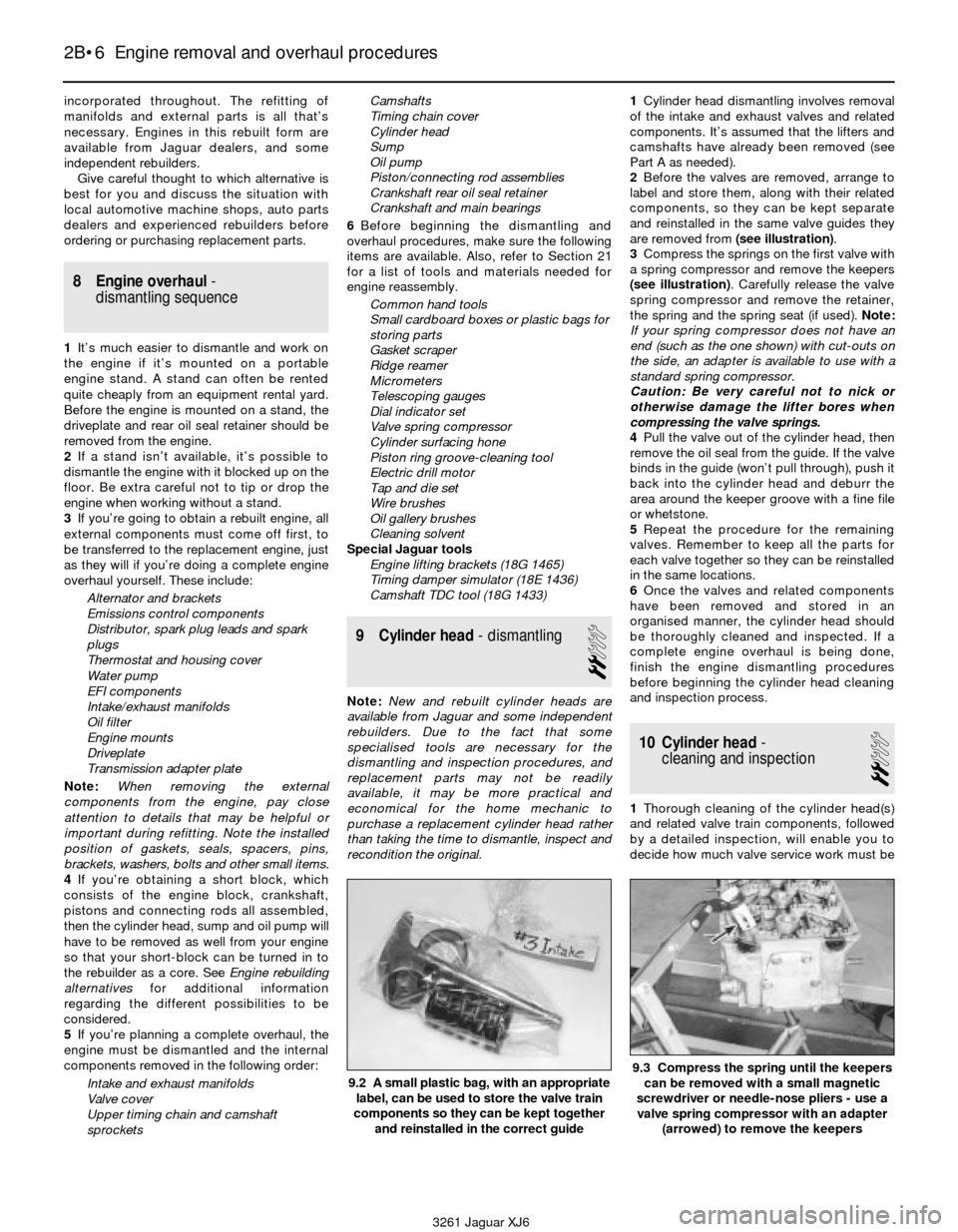
incorporated throughout. The refitting of
manifolds and external parts is all that’s
necessary. Engines in this rebuilt form are
available from Jaguar dealers, and some
independent rebuilders.
Give careful thought to which alternative is
best for you and discuss the situation with
local automotive machine shops, auto parts
dealers and experienced rebuilders before
ordering or purchasing replacement parts.
8 Engine overhaul-
dismantling sequence
1It’s much easier to dismantle and work on
the engine if it’s mounted on a portable
engine stand. A stand can often be rented
quite cheaply from an equipment rental yard.
Before the engine is mounted on a stand, the
driveplate and rear oil seal retainer should be
removed from the engine.
2If a stand isn’t available, it’s possible to
dismantle the engine with it blocked up on the
floor. Be extra careful not to tip or drop the
engine when working without a stand.
3If you’re going to obtain a rebuilt engine, all
external components must come off first, to
be transferred to the replacement engine, just
as they will if you’re doing a complete engine
overhaul yourself. These include:
Alternator and brackets
Emissions control components
Distributor, spark plug leads and spark
plugs
Thermostat and housing cover
Water pump
EFI components
Intake/exhaust manifolds
Oil filter
Engine mounts
Driveplate
Transmission adapter plate
Note:When removing the external
components from the engine, pay close
attention to details that may be helpful or
important during refitting. Note the installed
position of gaskets, seals, spacers, pins,
brackets, washers, bolts and other small items.
4If you’re obtaining a short block, which
consists of the engine block, crankshaft,
pistons and connecting rods all assembled,
then the cylinder head, sump and oil pump will
have to be removed as well from your engine
so that your short-block can be turned in to
the rebuilder as a core. See Engine rebuilding
alternativesfor additional information
regarding the different possibilities to be
considered.
5If you’re planning a complete overhaul, the
engine must be dismantled and the internal
components removed in the following order:
Intake and exhaust manifolds
Valve cover
Upper timing chain and camshaft
sprocketsCamshafts
Timing chain cover
Cylinder head
Sump
Oil pump
Piston/connecting rod assemblies
Crankshaft rear oil seal retainer
Crankshaft and main bearings
6Before beginning the dismantling and
overhaul procedures, make sure the following
items are available. Also, refer to Section 21
for a list of tools and materials needed for
engine reassembly.
Common hand tools
Small cardboard boxes or plastic bags for
storing parts
Gasket scraper
Ridge reamer
Micrometers
Telescoping gauges
Dial indicator set
Valve spring compressor
Cylinder surfacing hone
Piston ring groove-cleaning tool
Electric drill motor
Tap and die set
Wire brushes
Oil gallery brushes
Cleaning solvent
Special Jaguar tools
Engine lifting brackets (18G 1465)
Timing damper simulator (18E 1436)
Camshaft TDC tool (18G 1433)
9 Cylinder head- dismantling
2
Note: New and rebuilt cylinder heads are
available from Jaguar and some independent
rebuilders. Due to the fact that some
specialised tools are necessary for the
dismantling and inspection procedures, and
replacement parts may not be readily
available, it may be more practical and
economical for the home mechanic to
purchase a replacement cylinder head rather
than taking the time to dismantle, inspect and
recondition the original.1Cylinder head dismantling involves removal
of the intake and exhaust valves and related
components. It’s assumed that the lifters and
camshafts have already been removed (see
Part A as needed).
2Before the valves are removed, arrange to
label and store them, along with their related
components, so they can be kept separate
and reinstalled in the same valve guides they
are removed from (see illustration).
3Compress the springs on the first valve with
a spring compressor and remove the keepers
(see illustration). Carefully release the valve
spring compressor and remove the retainer,
the spring and the spring seat (if used). Note:
If your spring compressor does not have an
end (such as the one shown) with cut-outs on
the side, an adapter is available to use with a
standard spring compressor.
Caution: Be very careful not to nick or
otherwise damage the lifter bores when
compressing the valve springs.
4Pull the valve out of the cylinder head, then
remove the oil seal from the guide. If the valve
binds in the guide (won’t pull through), push it
back into the cylinder head and deburr the
area around the keeper groove with a fine file
or whetstone.
5Repeat the procedure for the remaining
valves. Remember to keep all the parts for
each valve together so they can be reinstalled
in the same locations.
6Once the valves and related components
have been removed and stored in an
organised manner, the cylinder head should
be thoroughly cleaned and inspected. If a
complete engine overhaul is being done,
finish the engine dismantling procedures
before beginning the cylinder head cleaning
and inspection process.
10 Cylinder head-
cleaning and inspection
2
1Thorough cleaning of the cylinder head(s)
and related valve train components, followed
by a detailed inspection, will enable you to
decide how much valve service work must be
2B•6 Engine removal and overhaul procedures
9.2 A small plastic bag, with an appropriate
label, can be used to store the valve train
components so they can be kept together
and reinstalled in the correct guide
3261 Jaguar XJ6
9.3 Compress the spring until the keepers
can be removed with a small magnetic
screwdriver or needle-nose pliers - use a
valve spring compressor with an adapter
(arrowed) to remove the keepers
Page 62 of 227

done during the engine overhaul. Note:If the
engine was severely overheated, the cylinder
head is probably warped (see paragraph 12).
Cleaning
2Scrape all traces of old gasket material and
sealing compound off the cylinder head
gasket, intake manifold and exhaust manifold
sealing surfaces. Be very careful not to gouge
the cylinder head. Special gasket-removal
solvents that soften gaskets and make
removal much easier are available at car
accessory outlets.
3Remove all built up scale from the coolant
passages.
4Run a stiff wire brush through the various
holes to remove deposits that may have
formed in them. If there are heavy deposits in
the water passages, the bare head should be
professionally cleaned at a machine
workshop.
5Run an appropriate-size tap into each of the
threaded holes to remove corrosion and
any thread sealant that may be present. If
compressed air is available, use it to clear the
holes of debris produced by this operation.
Warning: Wear eye protection
when using compressed air!
6Clean the exhaust and intake manifold stud
threads with a wire brush.
7Clean the cylinder head with solvent and dry
it thoroughly. Compressed air will speed the
drying process and ensure that all holes and
recessed areas are clean. Note:Decarbonising
chemicals are available and may prove very
useful when cleaning cylinder heads and valve
train components. They are very caustic and
should be used with caution. Be sure to follow
the instructions on the container.
8Clean the lifters with solvent and dry themthoroughly. Compressed air will speed the
drying process and can be used to clean out
the oil passages. Don’t mix them up during
cleaning - keep them in a box with numbered
compartments.
9Clean all the valve springs, spring seats,
keepers and retainers with solvent and dry
them thoroughly. Work on the components
from one valve at a time to avoid mixing up
the parts.
10Scrape off any heavy deposits that may
have formed on the valves, then use a
motorised wire brush to remove deposits from
the valve heads and stems. Again, make sure
that the valves don’t get mixed up.
Inspection
Note:Be sure to perform all of the following
inspection procedures before concluding that
machine workshop work is required. Make a
list of the items that need attention. The
inspection procedures for the lifters and
camshafts, can be found in Part A.
Cylinder head
11Inspect the cylinder head very carefully for
cracks, evidence of coolant leakage and other
damage. If cracks are found, check with an
automotive machine workshop concerning
repair. If repair isn’t possible, a new cylinder
head should be obtained.
12A common problem on aluminium engines
is erosion of the cylinder head or engine block
coolant passages due to improper sealing.
Using a new cylinder head gasket held
against the cylinder head, trace the bolt holes
and coolant passage outlines in pencil on the
cylinder head. Use the gasket to trace the
same on the top of the engine block (see
illustration). If the top of the engine block has
eroded outsideof the pattern around thewater passages or cylinder head bolt holes,
the engine block must be renewed; the
manufacturer doesn’t recommend resurfacing
it. If the cylinder head has eroded outside of
the water passage holes but the erosion is
away fromthe combustion chamber, the
eroded area can be built up with metal-
impregnated epoxy and machined flat again.
13Using a straightedge and feeler gauge,
check the cylinder head gasket mating
surface (on the engine block and cylinder
head) for warpage (see illustration). If the
warpage exceeds the limit found in this
Chapter’s Specifications, it can be resurfaced
at an automotive machine workshop, but no
more then 0.010-inch of material should be
removed. If the cylinder head had been
overheated, take it to the machinist for
inspection before proceeding further. It’s
possible that the overheating could have
annealed (softened) the aluminium of the
cylinder head, making it unsuitable for
machine work. In this case, a new cylinder
head is required.
Note 1:To check if a cylinder head has been
machined previously, measure the height
between the cylinder head gasket surface and
the valve cover mounting surface with a large
micrometer or vernier caliper and compare
with Specifications.
Note 2:Jaguar aluminium cylinder heads
require precision machine work. It is best to
find a machine workshop that has
considerable experience in servicing Jaguar
cylinder heads.
14Examine the valve seats in each of the
combustion chambers. If they’re pitted,
cracked or burned, the cylinder head will
require valve service that’s beyond the scope
of the home mechanic.
Engine removal and overhaul procedures 2B•7
2B
3261 Jaguar XJ6 10.12 Place the new head gasket on the engine block, and trace
around the water passages and bolt holes - make sure there is no
erosion of the aluminium beyond these lines
10.13 Check the cylinder head and engine block gasket surfaces
for warpage by trying to slip a feeler gauge under a precision
straightedge (see the Specifications for the maximum warpage
allowed and use a feeler gauge of that thickness) - check both the
cylinder head and engine block (shown)
Page 63 of 227
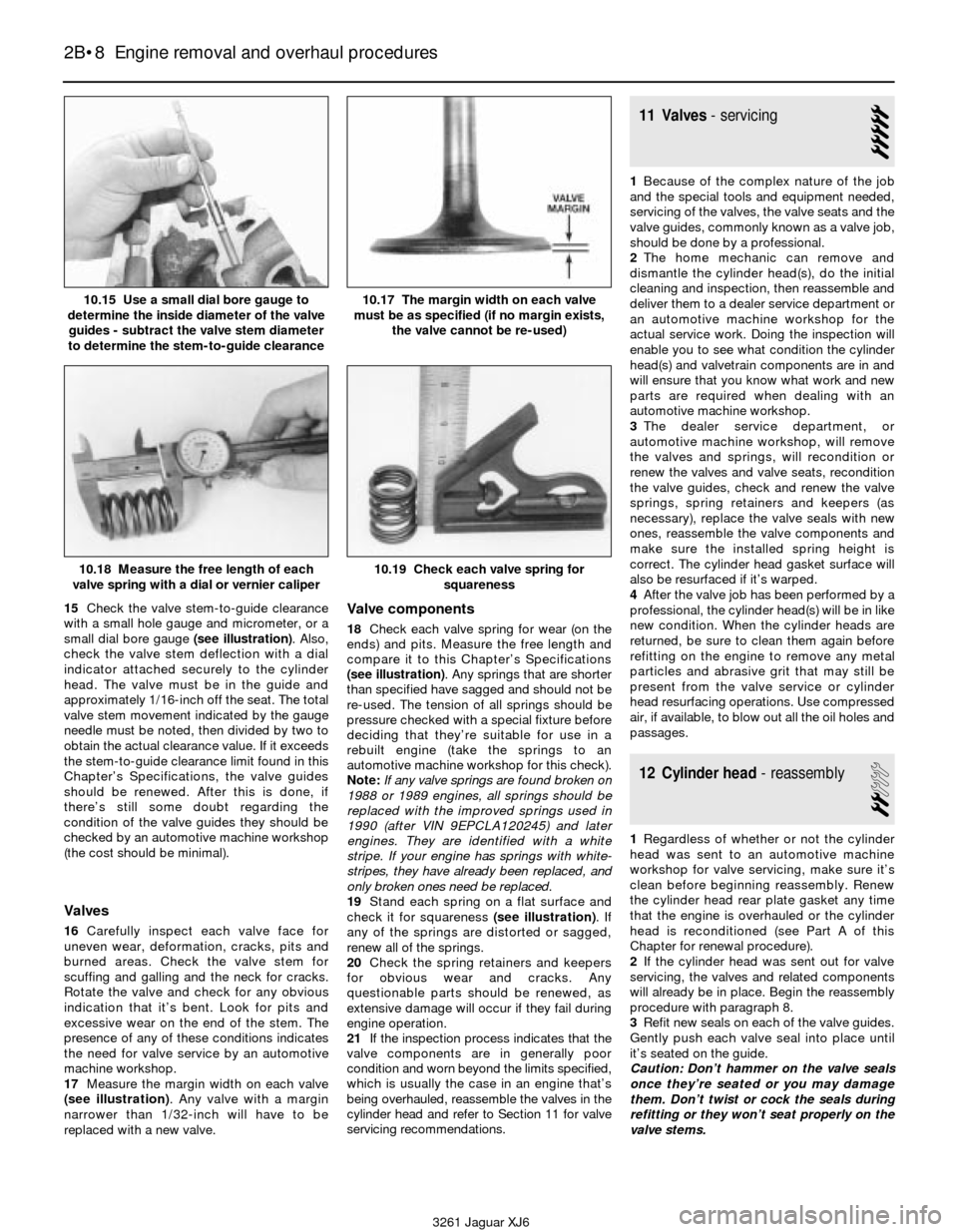
15Check the valve stem-to-guide clearance
with a small hole gauge and micrometer, or a
small dial bore gauge (see illustration). Also,
check the valve stem deflection with a dial
indicator attached securely to the cylinder
head. The valve must be in the guide and
approximately 1/16-inch off the seat. The total
valve stem movement indicated by the gauge
needle must be noted, then divided by two to
obtain the actual clearance value. If it exceeds
the stem-to-guide clearance limit found in this
Chapter’s Specifications, the valve guides
should be renewed. After this is done, if
there’s still some doubt regarding the
condition of the valve guides they should be
checked by an automotive machine workshop
(the cost should be minimal).
Valves
16Carefully inspect each valve face for
uneven wear, deformation, cracks, pits and
burned areas. Check the valve stem for
scuffing and galling and the neck for cracks.
Rotate the valve and check for any obvious
indication that it’s bent. Look for pits and
excessive wear on the end of the stem. The
presence of any of these conditions indicates
the need for valve service by an automotive
machine workshop.
17Measure the margin width on each valve
(see illustration). Any valve with a margin
narrower than 1/32-inch will have to be
replaced with a new valve.
Valve components
18Check each valve spring for wear (on the
ends) and pits. Measure the free length and
compare it to this Chapter’s Specifications
(see illustration). Any springs that are shorter
than specified have sagged and should not be
re-used. The tension of all springs should be
pressure checked with a special fixture before
deciding that they’re suitable for use in a
rebuilt engine (take the springs to an
automotive machine workshop for this check).
Note:If any valve springs are found broken on
1988 or 1989 engines, all springs should be
replaced with the improved springs used in
1990 (after VIN 9EPCLA120245) and later
engines. They are identified with a white
stripe. If your engine has springs with white-
stripes, they have already been replaced, and
only broken ones need be replaced.
19Stand each spring on a flat surface and
check it for squareness (see illustration). If
any of the springs are distorted or sagged,
renew all of the springs.
20Check the spring retainers and keepers
for obvious wear and cracks. Any
questionable parts should be renewed, as
extensive damage will occur if they fail during
engine operation.
21If the inspection process indicates that the
valve components are in generally poor
condition and worn beyond the limits specified,
which is usually the case in an engine that’s
being overhauled, reassemble the valves in the
cylinder head and refer to Section 11 for valve
servicing recommendations.
11 Valves- servicing
5
1Because of the complex nature of the job
and the special tools and equipment needed,
servicing of the valves, the valve seats and the
valve guides, commonly known as a valve job,
should be done by a professional.
2The home mechanic can remove and
dismantle the cylinder head(s), do the initial
cleaning and inspection, then reassemble and
deliver them to a dealer service department or
an automotive machine workshop for the
actual service work. Doing the inspection will
enable you to see what condition the cylinder
head(s) and valvetrain components are in and
will ensure that you know what work and new
parts are required when dealing with an
automotive machine workshop.
3The dealer service department, or
automotive machine workshop, will remove
the valves and springs, will recondition or
renew the valves and valve seats, recondition
the valve guides, check and renew the valve
springs, spring retainers and keepers (as
necessary), replace the valve seals with new
ones, reassemble the valve components and
make sure the installed spring height is
correct. The cylinder head gasket surface will
also be resurfaced if it’s warped.
4After the valve job has been performed by a
professional, the cylinder head(s) will be in like
new condition. When the cylinder heads are
returned, be sure to clean them again before
refitting on the engine to remove any metal
particles and abrasive grit that may still be
present from the valve service or cylinder
head resurfacing operations. Use compressed
air, if available, to blow out all the oil holes and
passages.
12 Cylinder head- reassembly
2
1Regardless of whether or not the cylinder
head was sent to an automotive machine
workshop for valve servicing, make sure it’s
clean before beginning reassembly. Renew
the cylinder head rear plate gasket any time
that the engine is overhauled or the cylinder
head is reconditioned (see Part A of this
Chapter for renewal procedure).
2If the cylinder head was sent out for valve
servicing, the valves and related components
will already be in place. Begin the reassembly
procedure with paragraph 8.
3Refit new seals on each of the valve guides.
Gently push each valve seal into place until
it’s seated on the guide.
Caution: Don’t hammer on the valve seals
once they’re seated or you may damage
them. Don’t twist or cock the seals during
refitting or they won’t seat properly on the
valve stems.
2B•8 Engine removal and overhaul procedures
10.15 Use a small dial bore gauge to
determine the inside diameter of the valve
guides - subtract the valve stem diameter
to determine the stem-to-guide clearance10.17 The margin width on each valve
must be as specified (if no margin exists,
the valve cannot be re-used)
10.18 Measure the free length of each
valve spring with a dial or vernier caliper10.19 Check each valve spring for
squareness
3261 Jaguar XJ6
Page 64 of 227
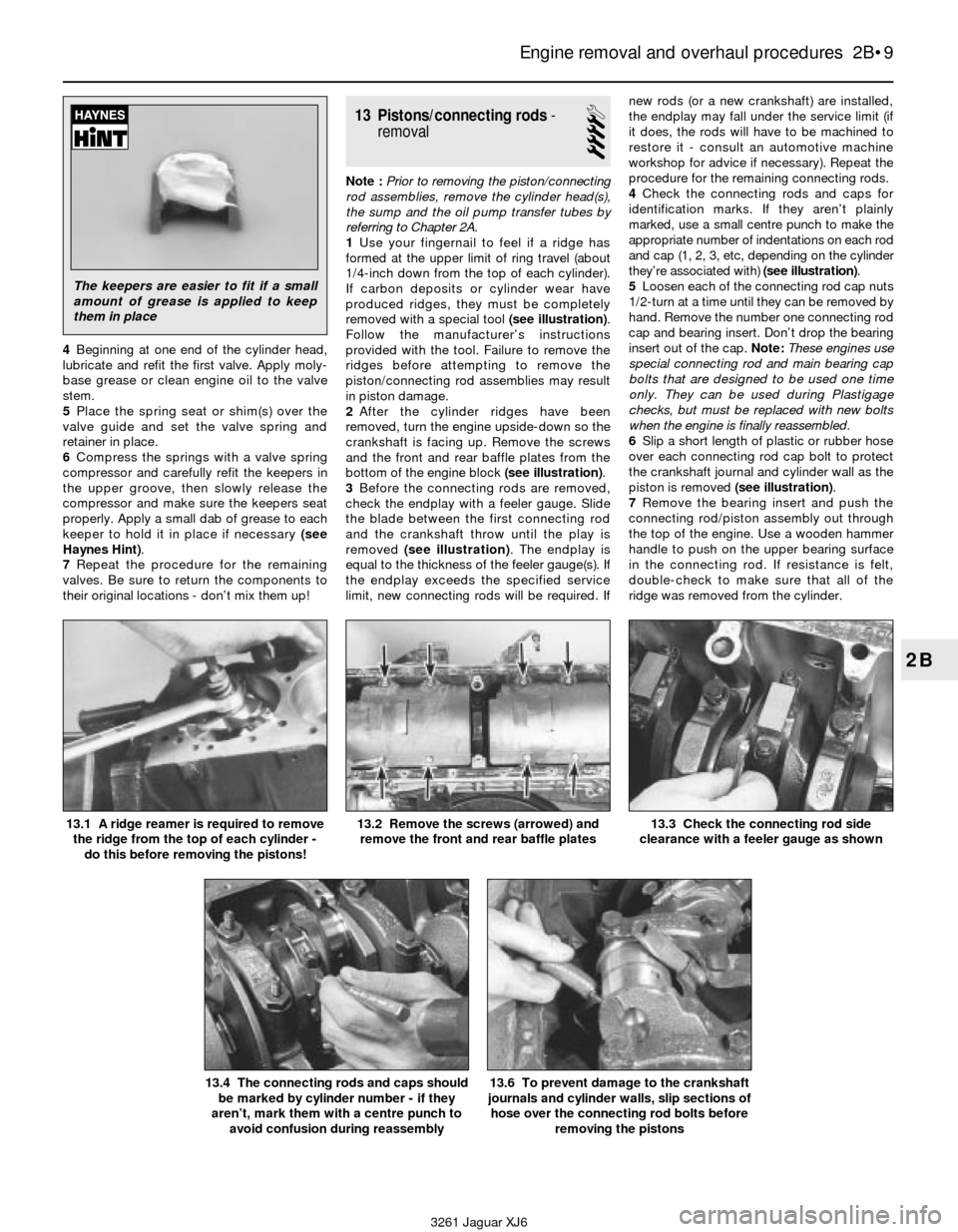
4Beginning at one end of the cylinder head,
lubricate and refit the first valve. Apply moly-
base grease or clean engine oil to the valve
stem.
5Place the spring seat or shim(s) over the
valve guide and set the valve spring and
retainer in place.
6Compress the springs with a valve spring
compressor and carefully refit the keepers in
the upper groove, then slowly release the
compressor and make sure the keepers seat
properly. Apply a small dab of grease to each
keeper to hold it in place if necessary (see
Haynes Hint).
7Repeat the procedure for the remaining
valves. Be sure to return the components to
their original locations - don’t mix them up!
13 Pistons/connecting rods-
removal
4
Note :Prior to removing the piston/connecting
rod assemblies, remove the cylinder head(s),
the sump and the oil pump transfer tubes by
referring to Chapter 2A.
1Use your fingernail to feel if a ridge has
formed at the upper limit of ring travel (about
1/4-inch down from the top of each cylinder).
If carbon deposits or cylinder wear have
produced ridges, they must be completely
removed with a special tool (see illustration).
Follow the manufacturer’s instructions
provided with the tool. Failure to remove the
ridges before attempting to remove the
piston/connecting rod assemblies may result
in piston damage.
2After the cylinder ridges have been
removed, turn the engine upside-down so the
crankshaft is facing up. Remove the screws
and the front and rear baffle plates from the
bottom of the engine block (see illustration).
3Before the connecting rods are removed,
check the endplay with a feeler gauge. Slide
the blade between the first connecting rod
and the crankshaft throw until the play is
removed (see illustration). The endplay is
equal to the thickness of the feeler gauge(s). If
the endplay exceeds the specified service
limit, new connecting rods will be required. Ifnew rods (or a new crankshaft) are installed,
the endplay may fall under the service limit (if
it does, the rods will have to be machined to
restore it - consult an automotive machine
workshop for advice if necessary). Repeat the
procedure for the remaining connecting rods.
4Check the connecting rods and caps for
identification marks. If they aren’t plainly
marked, use a small centre punch to make the
appropriate number of indentations on each rod
and cap (1, 2, 3, etc, depending on the cylinder
they’re associated with) (see illustration).
5Loosen each of the connecting rod cap nuts
1/2-turn at a time until they can be removed by
hand. Remove the number one connecting rod
cap and bearing insert. Don’t drop the bearing
insert out of the cap. Note:These engines use
special connecting rod and main bearing cap
bolts that are designed to be used one time
only. They can be used during Plastigage
checks, but must be replaced with new bolts
when the engine is finally reassembled.
6Slip a short length of plastic or rubber hose
over each connecting rod cap bolt to protect
the crankshaft journal and cylinder wall as the
piston is removed (see illustration).
7Remove the bearing insert and push the
connecting rod/piston assembly out through
the top of the engine. Use a wooden hammer
handle to push on the upper bearing surface
in the connecting rod. If resistance is felt,
double-check to make sure that all of the
ridge was removed from the cylinder.
Engine removal and overhaul procedures 2B•9
2B
13.2 Remove the screws (arrowed) and
remove the front and rear baffle plates13.3 Check the connecting rod side
clearance with a feeler gauge as shown
13.4 The connecting rods and caps should
be marked by cylinder number - if they
aren’t, mark them with a centre punch to
avoid confusion during reassembly13.6 To prevent damage to the crankshaft
journals and cylinder walls, slip sections of
hose over the connecting rod bolts before
removing the pistons
3261 Jaguar XJ6 13.1 A ridge reamer is required to remove
the ridge from the top of each cylinder -
do this before removing the pistons!
The keepers are easier to fit if a small
amount of grease is applied to keep
them in place
Page 69 of 227
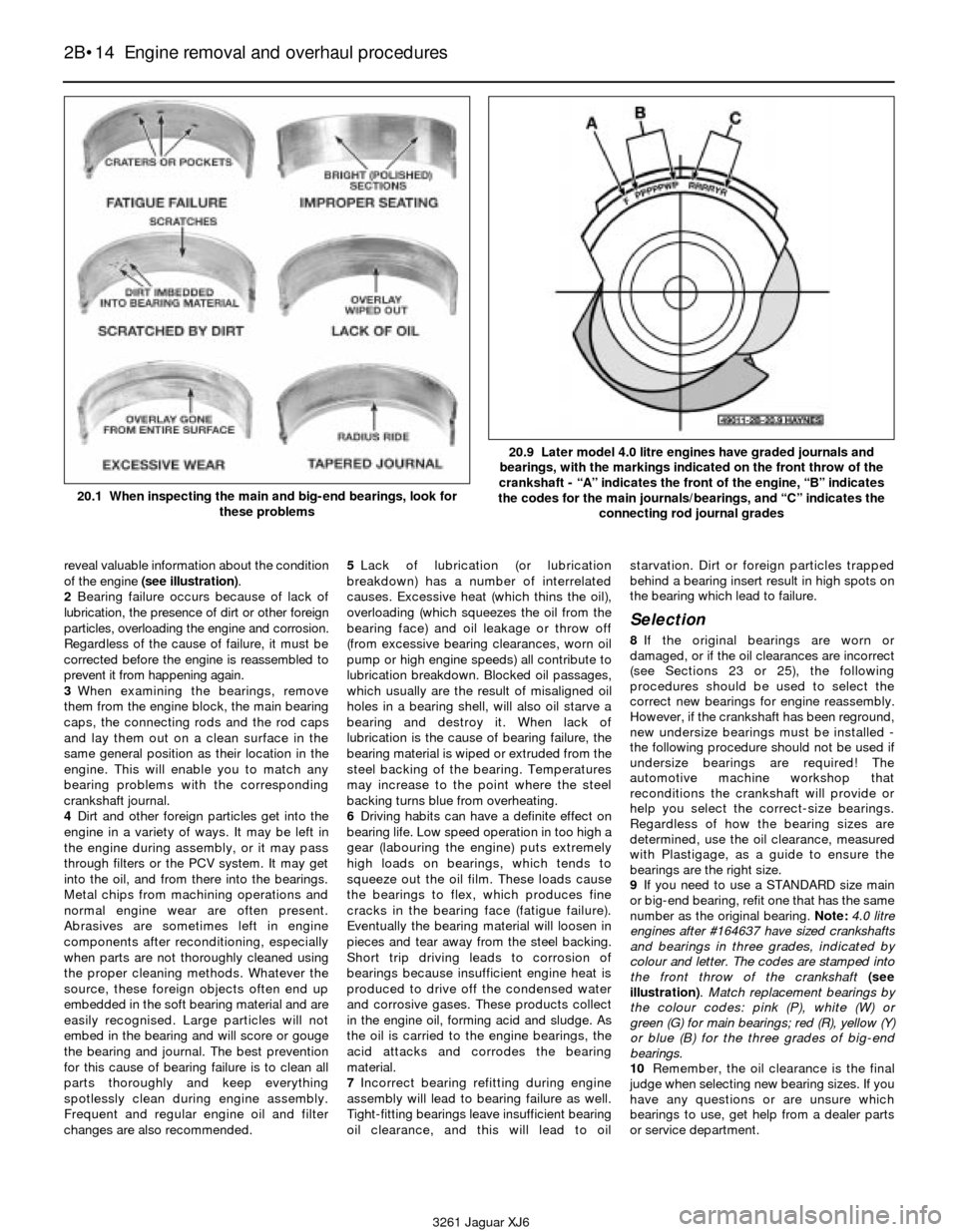
reveal valuable information about the condition
of the engine (see illustration).
2Bearing failure occurs because of lack of
lubrication, the presence of dirt or other foreign
particles, overloading the engine and corrosion.
Regardless of the cause of failure, it must be
corrected before the engine is reassembled to
prevent it from happening again.
3When examining the bearings, remove
them from the engine block, the main bearing
caps, the connecting rods and the rod caps
and lay them out on a clean surface in the
same general position as their location in the
engine. This will enable you to match any
bearing problems with the corresponding
crankshaft journal.
4Dirt and other foreign particles get into the
engine in a variety of ways. It may be left in
the engine during assembly, or it may pass
through filters or the PCV system. It may get
into the oil, and from there into the bearings.
Metal chips from machining operations and
normal engine wear are often present.
Abrasives are sometimes left in engine
components after reconditioning, especially
when parts are not thoroughly cleaned using
the proper cleaning methods. Whatever the
source, these foreign objects often end up
embedded in the soft bearing material and are
easily recognised. Large particles will not
embed in the bearing and will score or gouge
the bearing and journal. The best prevention
for this cause of bearing failure is to clean all
parts thoroughly and keep everything
spotlessly clean during engine assembly.
Frequent and regular engine oil and filter
changes are also recommended.5Lack of lubrication (or lubrication
breakdown) has a number of interrelated
causes. Excessive heat (which thins the oil),
overloading (which squeezes the oil from the
bearing face) and oil leakage or throw off
(from excessive bearing clearances, worn oil
pump or high engine speeds) all contribute to
lubrication breakdown. Blocked oil passages,
which usually are the result of misaligned oil
holes in a bearing shell, will also oil starve a
bearing and destroy it. When lack of
lubrication is the cause of bearing failure, the
bearing material is wiped or extruded from the
steel backing of the bearing. Temperatures
may increase to the point where the steel
backing turns blue from overheating.
6Driving habits can have a definite effect on
bearing life. Low speed operation in too high a
gear (labouring the engine) puts extremely
high loads on bearings, which tends to
squeeze out the oil film. These loads cause
the bearings to flex, which produces fine
cracks in the bearing face (fatigue failure).
Eventually the bearing material will loosen in
pieces and tear away from the steel backing.
Short trip driving leads to corrosion of
bearings because insufficient engine heat is
produced to drive off the condensed water
and corrosive gases. These products collect
in the engine oil, forming acid and sludge. As
the oil is carried to the engine bearings, the
acid attacks and corrodes the bearing
material.
7Incorrect bearing refitting during engine
assembly will lead to bearing failure as well.
Tight-fitting bearings leave insufficient bearing
oil clearance, and this will lead to oilstarvation. Dirt or foreign particles trapped
behind a bearing insert result in high spots on
the bearing which lead to failure.
Selection
8If the original bearings are worn or
damaged, or if the oil clearances are incorrect
(see Sections 23 or 25), the following
procedures should be used to select the
correct new bearings for engine reassembly.
However, if the crankshaft has been reground,
new undersize bearings must be installed -
the following procedure should not be used if
undersize bearings are required! The
automotive machine workshop that
reconditions the crankshaft will provide or
help you select the correct-size bearings.
Regardless of how the bearing sizes are
determined, use the oil clearance, measured
with Plastigage, as a guide to ensure the
bearings are the right size.
9If you need to use a STANDARD size main
or big-end bearing, refit one that has the same
number as the original bearing. Note:4.0 litre
engines after #164637 have sized crankshafts
and bearings in three grades, indicated by
colour and letter. The codes are stamped into
the front throw of the crankshaft(see
illustration). Match replacement bearings by
the colour codes: pink (P), white (W) or
green (G) for main bearings; red (R), yellow (Y)
or blue (B) for the three grades of big-end
bearings.
10Remember, the oil clearance is the final
judge when selecting new bearing sizes. If you
have any questions or are unsure which
bearings to use, get help from a dealer parts
or service department.
2B•14 Engine removal and overhaul procedures
3261 Jaguar XJ6 20.1 When inspecting the main and big-end bearings, look for
these problems
20.9 Later model 4.0 litre engines have graded journals and
bearings, with the markings indicated on the front throw of the
crankshaft - “A” indicates the front of the engine, “B” indicates
the codes for the main journals/bearings, and “C” indicates the
connecting rod journal grades
Page 78 of 227
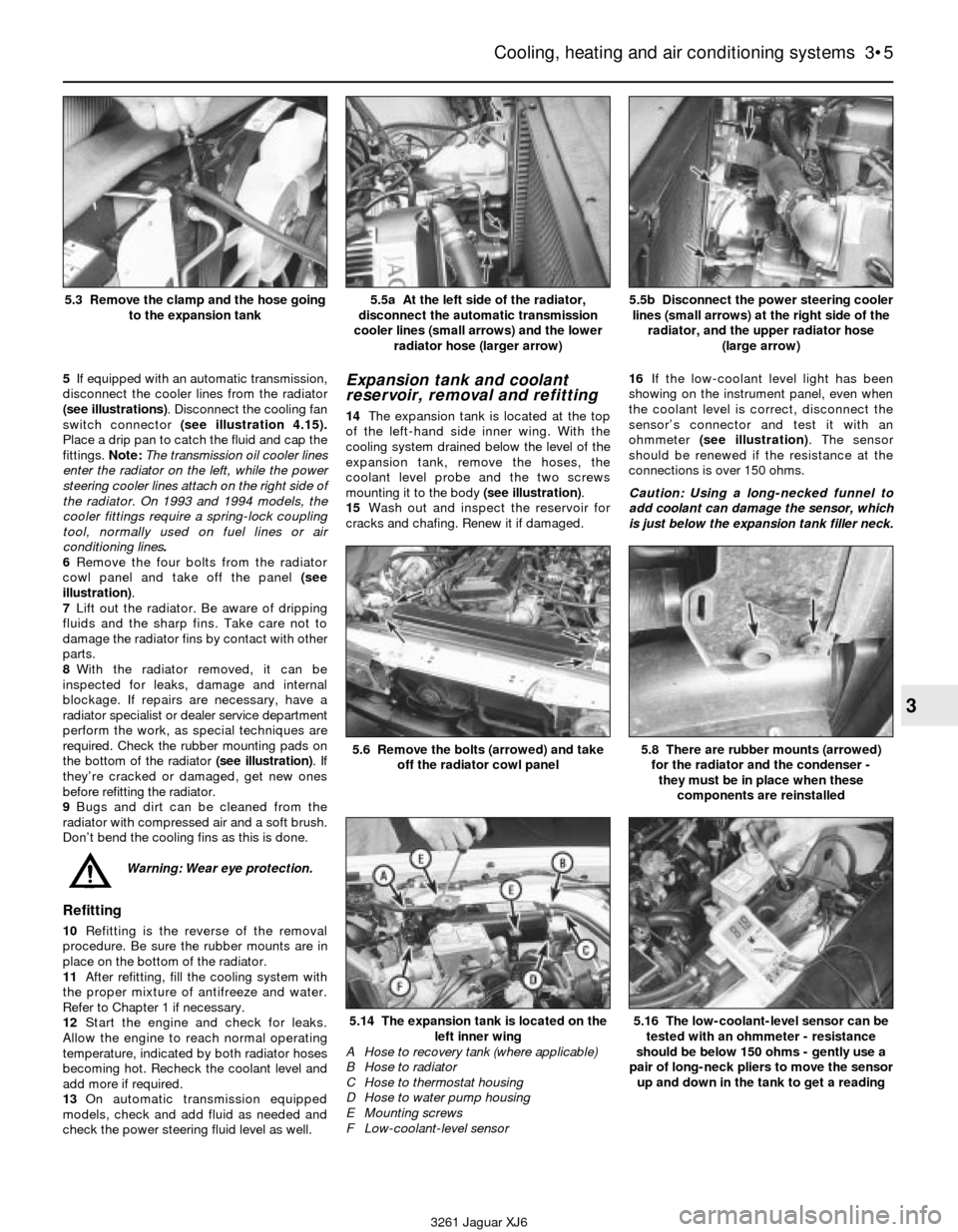
5If equipped with an automatic transmission,
disconnect the cooler lines from the radiator
(see illustrations). Disconnect the cooling fan
switch connector (see illustration 4.15).
Place a drip pan to catch the fluid and cap the
fittings. Note:The transmission oil cooler lines
enter the radiator on the left, while the power
steering cooler lines attach on the right side of
the radiator. On 1993 and 1994 models, the
cooler fittings require a spring-lock coupling
tool, normally used on fuel lines or air
conditioning lines.
6Remove the four bolts from the radiator
cowl panel and take off the panel (see
illustration).
7Lift out the radiator. Be aware of dripping
fluids and the sharp fins. Take care not to
damage the radiator fins by contact with other
parts.
8With the radiator removed, it can be
inspected for leaks, damage and internal
blockage. If repairs are necessary, have a
radiator specialist or dealer service department
perform the work, as special techniques are
required. Check the rubber mounting pads on
the bottom of the radiator (see illustration). If
they’re cracked or damaged, get new ones
before refitting the radiator.
9Bugs and dirt can be cleaned from the
radiator with compressed air and a soft brush.
Don’t bend the cooling fins as this is done.
Warning: Wear eye protection.
Refitting
10Refitting is the reverse of the removal
procedure. Be sure the rubber mounts are in
place on the bottom of the radiator.
11After refitting, fill the cooling system with
the proper mixture of antifreeze and water.
Refer to Chapter 1 if necessary.
12Start the engine and check for leaks.
Allow the engine to reach normal operating
temperature, indicated by both radiator hoses
becoming hot. Recheck the coolant level and
add more if required.
13On automatic transmission equipped
models, check and add fluid as needed and
check the power steering fluid level as well.
Expansion tank and coolant
reservoir, removal and refitting
14The expansion tank is located at the top
of the left-hand side inner wing. With the
cooling system drained below the level of the
expansion tank, remove the hoses, the
coolant level probe and the two screws
mounting it to the body (see illustration).
15Wash out and inspect the reservoir for
cracks and chafing. Renew it if damaged.16If the low-coolant level light has been
showing on the instrument panel, even when
the coolant level is correct, disconnect the
sensor’s connector and test it with an
ohmmeter (see illustration). The sensor
should be renewed if the resistance at the
connections is over 150 ohms.
Caution: Using a long-necked funnel to
add coolant can damage the sensor, which
is just below the expansion tank filler neck.
Cooling, heating and air conditioning systems 3•5
3
5.5a At the left side of the radiator,
disconnect the automatic transmission
cooler lines (small arrows) and the lower
radiator hose (larger arrow)5.5b Disconnect the power steering cooler
lines (small arrows) at the right side of the
radiator, and the upper radiator hose
(large arrow)
3261 Jaguar XJ6 5.3 Remove the clamp and the hose going
to the expansion tank
5.6 Remove the bolts (arrowed) and take
off the radiator cowl panel
5.14 The expansion tank is located on the
left inner wing
A Hose to recovery tank (where applicable)
B Hose to radiator
C Hose to thermostat housing
D Hose to water pump housing
E Mounting screws
F Low-coolant-level sensor
5.8 There are rubber mounts (arrowed)
for the radiator and the condenser -
they must be in place when these
components are reinstalled
5.16 The low-coolant-level sensor can be
tested with an ohmmeter - resistance
should be below 150 ohms - gently use a
pair of long-neck pliers to move the sensor
up and down in the tank to get a reading
Page 80 of 227
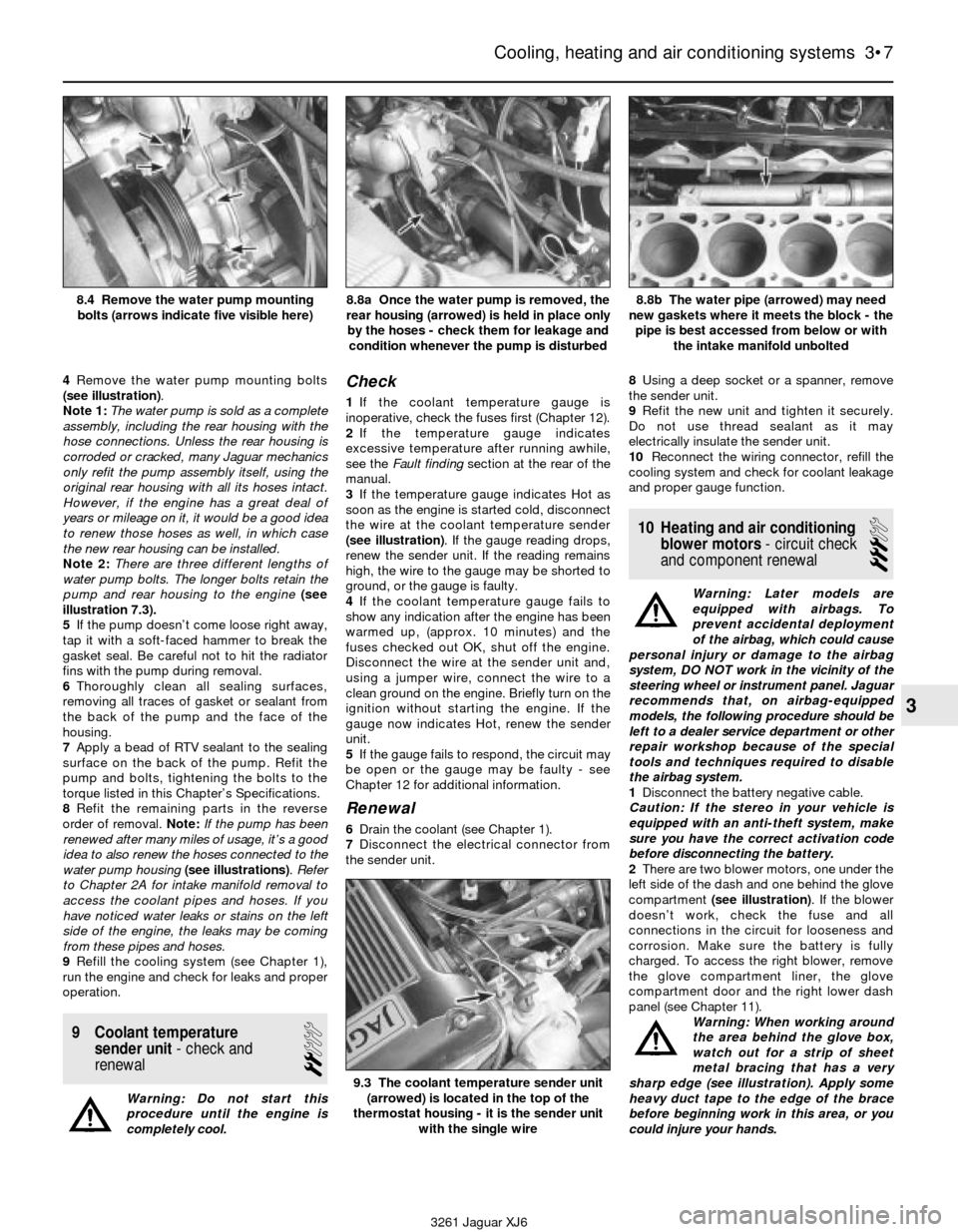
4Remove the water pump mounting bolts
(see illustration).
Note 1:The water pump is sold as a complete
assembly, including the rear housing with the
hose connections. Unless the rear housing is
corroded or cracked, many Jaguar mechanics
only refit the pump assembly itself, using the
original rear housing with all its hoses intact.
However, if the engine has a great deal of
years or mileage on it, it would be a good idea
to renew those hoses as well, in which case
the new rear housing can be installed.
Note 2:There are three different lengths of
water pump bolts. The longer bolts retain the
pump and rear housing to the engine(see
illustration 7.3).
5If the pump doesn’t come loose right away,
tap it with a soft-faced hammer to break the
gasket seal. Be careful not to hit the radiator
fins with the pump during removal.
6Thoroughly clean all sealing surfaces,
removing all traces of gasket or sealant from
the back of the pump and the face of the
housing.
7Apply a bead of RTV sealant to the sealing
surface on the back of the pump. Refit the
pump and bolts, tightening the bolts to the
torque listed in this Chapter’s Specifications.
8Refit the remaining parts in the reverse
order of removal. Note:If the pump has been
renewed after many miles of usage, it’s a good
idea to also renew the hoses connected to the
water pump housing(see illustrations). Refer
to Chapter 2A for intake manifold removal to
access the coolant pipes and hoses. If you
have noticed water leaks or stains on the left
side of the engine, the leaks may be coming
from these pipes and hoses.
9Refill the cooling system (see Chapter 1),
run the engine and check for leaks and proper
operation.
9 Coolant temperature
sender unit- check and
renewal
2
Warning: Do not start this
procedure until the engine is
completely cool.
Check
1If the coolant temperature gauge is
inoperative, check the fuses first (Chapter 12).
2If the temperature gauge indicates
excessive temperature after running awhile,
see the Fault finding section at the rear of the
manual.
3If the temperature gauge indicates Hot as
soon as the engine is started cold, disconnect
the wire at the coolant temperature sender
(see illustration). If the gauge reading drops,
renew the sender unit. If the reading remains
high, the wire to the gauge may be shorted to
ground, or the gauge is faulty.
4If the coolant temperature gauge fails to
show any indication after the engine has been
warmed up, (approx. 10 minutes) and the
fuses checked out OK, shut off the engine.
Disconnect the wire at the sender unit and,
using a jumper wire, connect the wire to a
clean ground on the engine. Briefly turn on the
ignition without starting the engine. If the
gauge now indicates Hot, renew the sender
unit.
5If the gauge fails to respond, the circuit may
be open or the gauge may be faulty - see
Chapter 12 for additional information.
Renewal
6Drain the coolant (see Chapter 1).
7Disconnect the electrical connector from
the sender unit.8Using a deep socket or a spanner, remove
the sender unit.
9Refit the new unit and tighten it securely.
Do not use thread sealant as it may
electrically insulate the sender unit.
10Reconnect the wiring connector, refill the
cooling system and check for coolant leakage
and proper gauge function.
10 Heating and air conditioning
blower motors- circuit check
and component renewal
3
Warning: Later models are
equipped with airbags. To
prevent accidental deployment
of the airbag, which could cause
personal injury or damage to the airbag
system, DO NOT work in the vicinity of the
steering wheel or instrument panel. Jaguar
recommends that, on airbag-equipped
models, the following procedure should be
left to a dealer service department or other
repair workshop because of the special
tools and techniques required to disable
the airbag system.
1Disconnect the battery negative cable.
Caution: If the stereo in your vehicle is
equipped with an anti-theft system, make
sure you have the correct activation code
before disconnecting the battery.
2There are two blower motors, one under the
left side of the dash and one behind the glove
compartment (see illustration). If the blower
doesn’t work, check the fuse and all
connections in the circuit for looseness and
corrosion. Make sure the battery is fully
charged. To access the right blower, remove
the glove compartment liner, the glove
compartment door and the right lower dash
panel (see Chapter 11).
Warning: When working around
the area behind the glove box,
watch out for a strip of sheet
metal bracing that has a very
sharp edge (see illustration). Apply some
heavy duct tape to the edge of the brace
before beginning work in this area, or you
could injure your hands.
Cooling, heating and air conditioning systems 3•7
3
8.4 Remove the water pump mounting
bolts (arrows indicate five visible here)8.8a Once the water pump is removed, the
rear housing (arrowed) is held in place only
by the hoses - check them for leakage and
condition whenever the pump is disturbed8.8b The water pipe (arrowed) may need
new gaskets where it meets the block - the
pipe is best accessed from below or with
the intake manifold unbolted
9.3 The coolant temperature sender unit
(arrowed) is located in the top of the
thermostat housing - it is the sender unit
with the single wire
3261 Jaguar XJ6
Page 82 of 227

11Separate the housing halves and pull up
the plastic plate holding the motor and fan
(see illustration). The fan doesn’t come off
the motor, but loosen the clamp-bolt on the
motor’s mount bracket and slide the motor
and fan out for renewal (see illustration).
Note:Some 1988 models had problems with
cracking of the fan blades and noise from the
blowers. These blowers and fans have been
superseded with improved parts, available
from your Jaguar dealer.
12When either blower housing is separated,
you’ll find two relays mounted inside (see
illustration). These are the blower isolation
relay and blower relay. Before refitting the
blower housing in the car, refer to Chapter 12
for testing of these relays.
13Refitting is the reverse of removal. Check
for proper operation.11 Heater core-
removal and refitting
4
Warning: Later model vehicles
are equipped with airbags. To
prevent the accidental deploy-
ment of the airbag, which could
cause personal injury or damage to the
airbag system, DO NOT work in the vicinity
of the steering wheel or instrument panel.
The manufacturer recommends that, on
airbag-equipped models, the following
procedure should be left to a dealer service
department or other repair workshop
because of the special tools and techniques
required to disable the airbag system.1Disconnect the battery negative cable.
Caution: If the stereo in your vehicle is
equipped with an anti-theft system, make
sure you have the correct activation code
before disconnecting the battery.
2Drain the cooling system (see Chapter 1).
Disconnect the heater hoses where they enter
the bulkhead (see illustration). Note:Use
compressed air in one of the pipes to blow out
any remaining coolant and collect it. This will
prevent any spills on the carpeting when the
heater core is removed. Plug the pipes to
prevent any remaining coolant from spilling out.
3Refer to Chapter 11 for removal of the
under-dash panels on both the driver and
passenger sides, and removal of the glovebox.
Warning: When working around
the area behind the glove box,
watch out for a strip of sheet
Cooling, heating and air conditioning systems 3•9
3
3261 Jaguar XJ6 10.11a Separate the housing halves - the blower motor (arrowed)
is attached to a plastic plate sandwiched between the
two housing halves
10.11b Loosen the clamp bolt (arrowed) on the motor bracket and
then pull the motor and fan out as an assembly
10.12 Inside the blower case are the blower and isolation relays
(arrowed) - while the case is apart, test these relays for
proper operation11.2 Disconnect the heater hoses from the pipes at the bulkhead
(small arrows) - the large arrow indicates the evaporator case
retaining nut
Page 83 of 227
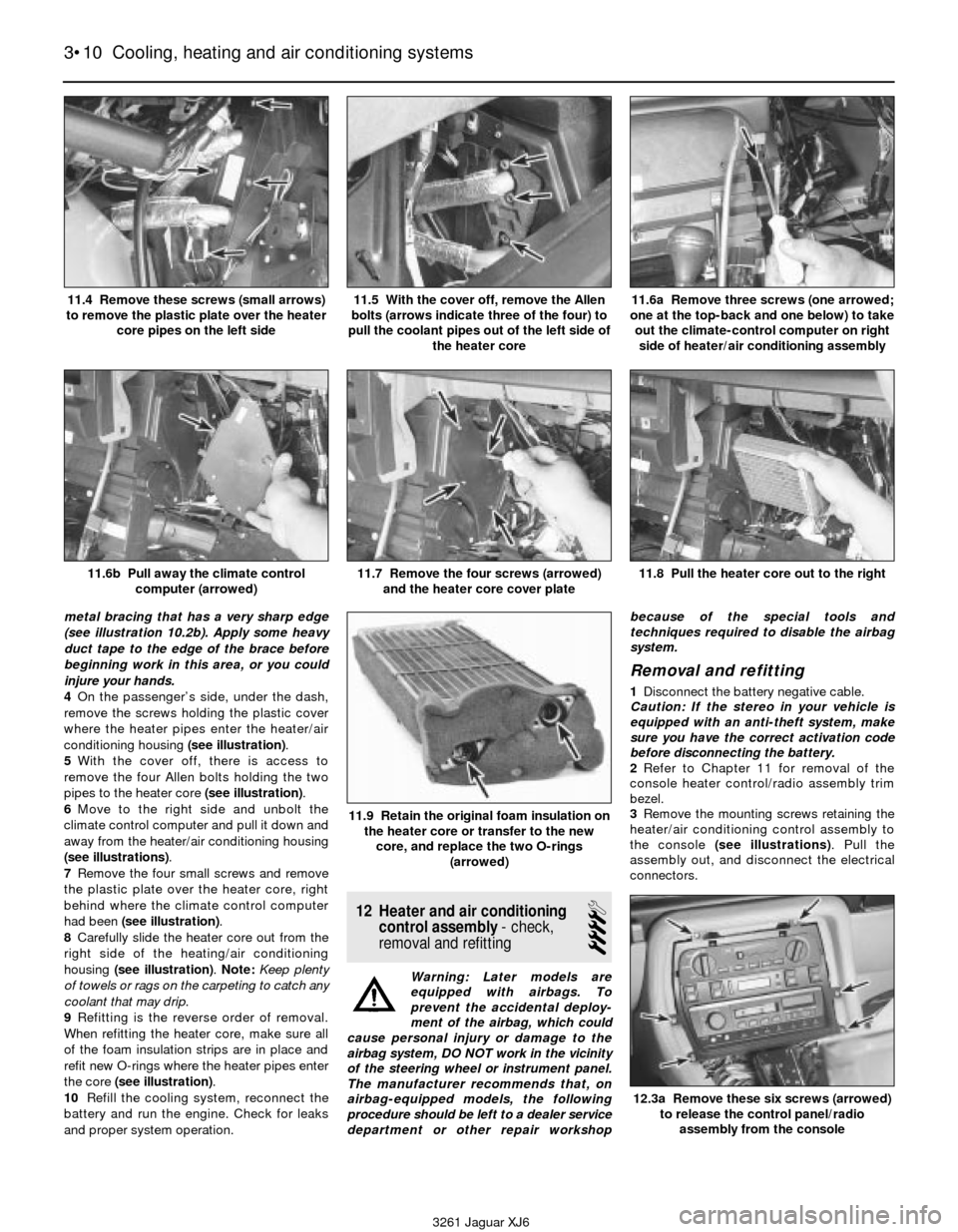
metal bracing that has a very sharp edge
(see illustration 10.2b). Apply some heavy
duct tape to the edge of the brace before
beginning work in this area, or you could
injure your hands.
4On the passenger’s side, under the dash,
remove the screws holding the plastic cover
where the heater pipes enter the heater/air
conditioning housing (see illustration).
5With the cover off, there is access to
remove the four Allen bolts holding the two
pipes to the heater core (see illustration).
6Move to the right side and unbolt the
climate control computer and pull it down and
away from the heater/air conditioning housing
(see illustrations).
7Remove the four small screws and remove
the plastic plate over the heater core, right
behind where the climate control computer
had been (see illustration).
8Carefully slide the heater core out from the
right side of the heating/air conditioning
housing (see illustration). Note:Keep plenty
of towels or rags on the carpeting to catch any
coolant that may drip.
9Refitting is the reverse order of removal.
When refitting the heater core, make sure all
of the foam insulation strips are in place and
refit new O-rings where the heater pipes enter
the core (see illustration).
10Refill the cooling system, reconnect the
battery and run the engine. Check for leaks
and proper system operation.
12 Heater and air conditioning
control assembly- check,
removal and refitting
4
Warning: Later models are
equipped with airbags. To
prevent the accidental deploy-
ment of the airbag, which could
cause personal injury or damage to the
airbag system, DO NOT work in the vicinity
of the steering wheel or instrument panel.
The manufacturer recommends that, on
airbag-equipped models, the following
procedure should be left to a dealer service
department or other repair workshopbecause of the special tools and
techniques required to disable the airbag
system.
Removal and refitting
1Disconnect the battery negative cable.
Caution: If the stereo in your vehicle is
equipped with an anti-theft system, make
sure you have the correct activation code
before disconnecting the battery.
2Refer to Chapter 11 for removal of the
console heater control/radio assembly trim
bezel.
3Remove the mounting screws retaining the
heater/air conditioning control assembly to
the console (see illustrations). Pull the
assembly out, and disconnect the electrical
connectors.
3•10 Cooling, heating and air conditioning systems
11.4 Remove these screws (small arrows)
to remove the plastic plate over the heater
core pipes on the left side11.5 With the cover off, remove the Allen
bolts (arrows indicate three of the four) to
pull the coolant pipes out of the left side of
the heater core11.6a Remove three screws (one arrowed;
one at the top-back and one below) to take
out the climate-control computer on right
side of heater/air conditioning assembly
11.6b Pull away the climate control
computer (arrowed)11.7 Remove the four screws (arrowed)
and the heater core cover plate11.8 Pull the heater core out to the right
3261 Jaguar XJ6
11.9 Retain the original foam insulation on
the heater core or transfer to the new
core, and replace the two O-rings
(arrowed)
12.3a Remove these six screws (arrowed)
to release the control panel/radio
assembly from the console